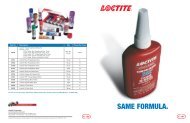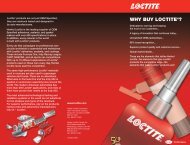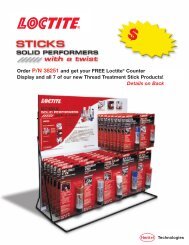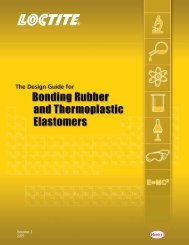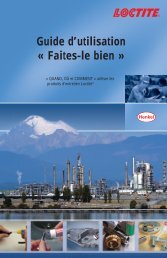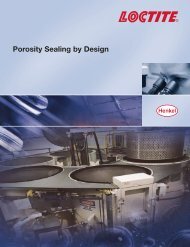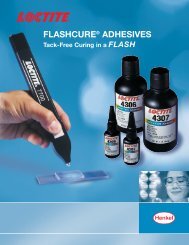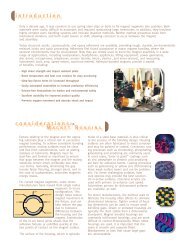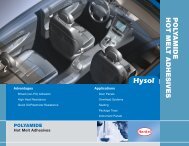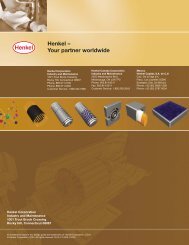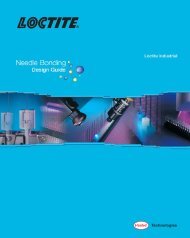Volume 4 - Loctite.ph
Volume 4 - Loctite.ph
Volume 4 - Loctite.ph
Create successful ePaper yourself
Turn your PDF publications into a flip-book with our unique Google optimized e-Paper software.
Polyethylene (LDPE, HDPE)ThermoplasticTrade Names Manufacturer• AspunDow Plastics• AttaneDow Plastics• BapoleneBamberger Polymers, Inc.• ClysarDuPont Company• DowlexDow Chemical Company• EscoreneExxon Mobil Chemical• FortiflexSolvay Polymers• Hostan GURHoescht Celanese Corporation• MarlexPhillips 66 Company• MicrotheneQuantum Chemical Company• NovapolNovacor Chemicals• PetrotheneQuantum Chemical• Polyfort FLPA. Schulman, Inc.• SclairNovacor Chemicals• TuflinUnion Carbide Corporation• Ultra-wearPolymer CorporationTypical Properties of Polyethylene (LDPE, HDPE)American EngineeringSIProcessing Temperature 300°F to 630°F 149°C to 332°CLinear Mold Shrinkage 0.017 to 0.050 in./in. 0.017 to 0.050 cm/cmMelting Point 210°F to 400°F 99°C to 204°CDensity 56.2 to 58.1 lb./ft. 3 0.90 to 0.93 g/cm 3Tensile Strength, Yield 1.1 to 2.0 lb./in. 2 x 10 3 0.8 to 1.4 kg/cm 2 x 10 2Tensile Strength, Break 1.1 to 5.8 lb./in. 2 x 10 3 0.8 to 4.1 kg/cm 2 x 10 2Elongation, Break 60.0 to 780.0% 60.0 to 780.0%Tensile Modulus 0.1 to 0.4 lb./in. 2 x 10 5 0.1 to 0.3 kg/cm 2 x 10 4Flexural Strength, Yield – –Flexural Modulus 0.2 to 0.5 lb./in. 2 x 10 5 0.1 to 0.4 kg/cm 2 x 10 4General DescriptionPolyethylene is a lightweight, semicrystalline thermoplastic producedby the liquid <strong>ph</strong>ase, free radical initiated polymerization of ethylene.The polymer is formed when the proper combination of pressure,temperature, and catalyst break open the double bonds within theethylene molecules. The amount of branching within the bulk polymerand its density can be controlled by varying the reaction conditions.An increase in the density of polyethylene leads to an increase in itshardness, surface abrasion, tensile strength, modulus, thermal stability,chemical resistance, and surface gloss but diminishes toughness, clarity,flexibility, elongation, and stress cracking resistance. Specialty gradesavailable include the four major density groups, namely I, II, III, and IV inorder of increasing density, UV stabilized, flame retardant, antistatic, andgrades with many different types of fillers. In 2004, the price of PE rangedapproximately from $0.75 to $1.50 per pound at truckload quantities.General PropertiesPolyethylene is not a high performance plastic suited for extreme serviceenvironments, but rather an extremely versatile and inexpensive resinthat has become one of the most popular of all plastics. Almost all ofpolyethylene’s properties vary greatly with changes in density andmolecular weight. Low density polyethylene has a relatively low strengthand hardness, but is flexible, clear, impact, creep and stress-crackresistant, and can have an elongation comparable to some rubbers. Highdensity polyethylene has significantly higher strength, hardness, abrasionand chemical resistance, but it sacrifices some of the properties inwhich low density polyethylene excels. Polyethylenes are not able towithstand high temperatures, but their chemical resistance is excellentfor an inexpensive, non-engineering resin. They are not recommendedfor continuous use with hydrocarbons, some alcohols, and oxidizingacids, but they are resistant to <strong>ph</strong>enols, ketones, esters, ethers, bases,salts, organic and inorganic acids.Compressive Strength – –Izod Notched, R.T. – –Hardness R44 - R55 Rockwell R44 - R55 RockwellThermal Conductivity 1.8 to 2.9 BTU-in./hr.-ft. 2 -°F 0.26 to 0.42 W/m-°KLinear ThermalExpansionDeflection Temperature@ 264 psiDeflection Temperature@ 66 psiContinuousService Temperature11.0 to 18.0 in./in.-°F x 10 -5 19.8 to 32.4 cm/cm-°C x10 -573°F to 126°F 23°C to 52°C100°F to 120°F 38°C to 49°C104°F to 158°F 40°C to 70°CDielectric Strength 475 to 900 V/10 -3 in. 1.9 to 3.5 V/mm x 10 4Dielectric Constant@ 1 MHzDissipation Factor@ 1 MHzWater Absorption,24 hr.2.2 to 2.4 2.2 to 2.40.0001 to 0.0005 0.0001 to 0.00050.01 to 1.5% 0.01 to 1.5%Typical Applications• Films – Shrink bundling, drum and bag liners, ice bags,shipping sacks, cling wrap, snack packaging, diaper liners• Packaging – Food and shipping containers, milk, water, antifreeze,and household chemical containers, squeeze bottles• Miscellaneous – Pipe and chemical drum liners, electric cablejacketing, toys, portable sanitary facilities, commercial storagetanks, envelopes50The <strong>Loctite</strong> ® Design Guide for Bonding Plastics, <strong>Volume</strong> 4



